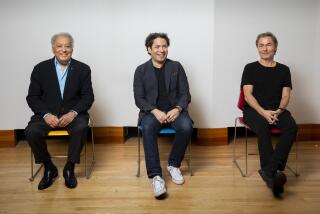Rethinking the Period Movement, One More Time
The most obvious characteristics of period performance practice are fast tempos, small forces, crispness of articulation (with minimal string vibrato), a simple dynamic scheme and lowered pitch--all on instruments of an earlier time.
A given is that in order to keep antiquarian performance from becoming a bad joke, its executants must be every bit as proficient as their colleagues on modern instruments.
With the burgeoning excellence of various period ensembles and the willingness of an increasing number of distinguished “modern” instrumentalists and singers to at least investigate antiquarian procedures, the period movement is no longer stigmatized, as it was as recently as a dozen years ago.
But in the view of harpsichordist-scholar Jesper Christensen, it’s time to question the validity of certain aspects of period performance.
Christensen is in effect telling those of us who only recently have come to terms with a presumed valid stylistic approach that we are accepting false coin: that the quick, nervy, small-ensemble interpretations of Corelli’s epochal Opus 6 Concerti Grossi espoused by Trevor Pinnock and his English Concert (Deutsche Grammophon Archiv 423 626, two CDs) and the even quicker, nervier and smaller ensemble style of Nicholas McGegan and his Philharmonia Baroque (Harmonia Mundi 907014/25, two CDs) are wrong.
To support his thesis, Christensen has enlisted a highly accomplished band of musicians, with violinist Chiara Banchini and her Ensemble 415 as its nucleus, and assembled “documentary evidence,” chiefly the observations of Franco-German composer Georg Muffat, who was in Rome during the 1680s to hear Corelli conduct concerti grossi--although we do not know whose .
Muffat tells us that Corelli used a large ensemble while employing very slow tempos in slow movements--slower, certainly, than those to which we have only recently become accustomed through the efforts of the aforementioned specialists.
The orchestra employed here (Harmonia Mundi 901406/7, two CDs), and in which Christensen plays the continuo harpsichord, numbers up to 39 players, with 16 violins and, gulp, four archlutes. Such numbers obviate some of the zippy danciness we’ve become used to, and the slow movements are indeed majestic.
The players are sufficiently adept to make the fast movements, which do move along smartly, work even with the large forces employed in eight of the 12 concertos. And, obviously, there’s no problem differentiating concertino from ripieno .
But whether it all works or not, whether it’s right or wrong, is perhaps beside the point. Of greater moment to those only recently enlightened in the ways of old-music-done-right is that with such endeavors as Christensen’s we are being offered alternatives, even new ultimate truths, to replace ones we’ve only barely assimilated.
Elsewhere, and more hearteningly, consider an as-yet only superficially examined wrinkle in the antiquarian picture: the effect period performance is having on thinking, mainstream musicians.
Take Neville Marriner, who, while often an outspoken critic of period performers, long ago absorbed certain dictums of period style through his mentor, the pioneering scholar and keyboardist Thurston Dart. Many of the names found in today’s period bands graduated from Marriner’s 1960s Academy of St. Martin in the Fields.
Pertinent examples of the current Marriner conducting style can be found in two of the great Haydn symphonies, Nos. 99 and 102 (Philips 432 139). Both emerge wittily, stylishly spirited and taut as played by today’s crack Academy, without the still off-putting, to some ears, sound of old instruments.
There is much the same sort of pleasure to be gained from modern-instrument performances of Haydn’s “Trauer” and “Oxford” symphonies, in which the Vienna Chamber Orchestra is vigorously conducted by Philippe Entremont, once (perhaps still) a noted pianist in the Romantic repertory, who seems utterly at home with the sharper inflections, leaner textures and less “interpretive” style promulgated by the period people (Harmonia Mundi 1901362, mid-price).
Both programs, Marriner’s and Entremont’s, project the wit and energy, the tightly tucked rhythmic corners and spare lyricism, that make Haydn at his best such an exhilarating experience.
More to Read
The biggest entertainment stories
Get our big stories about Hollywood, film, television, music, arts, culture and more right in your inbox as soon as they publish.
You may occasionally receive promotional content from the Los Angeles Times.










